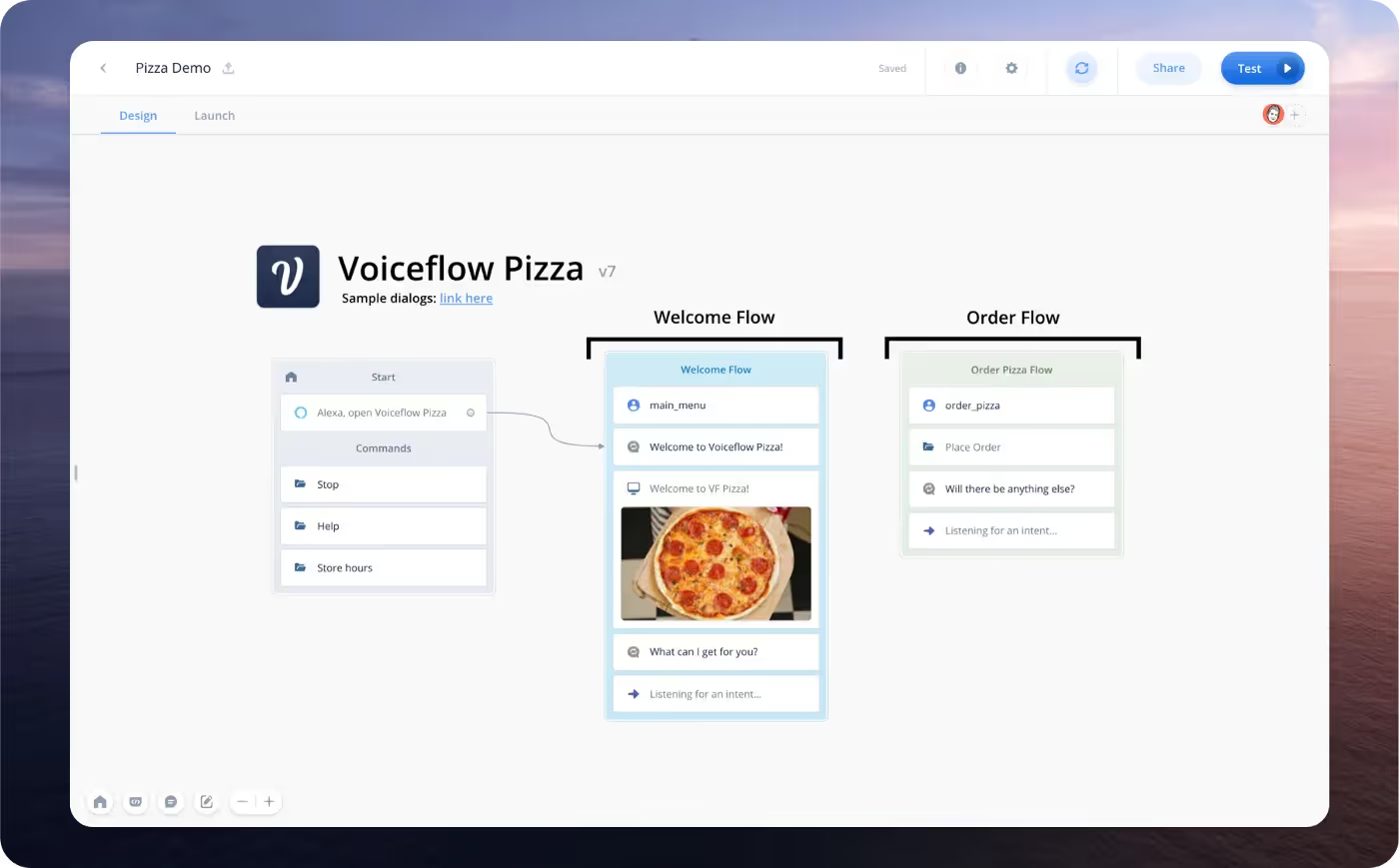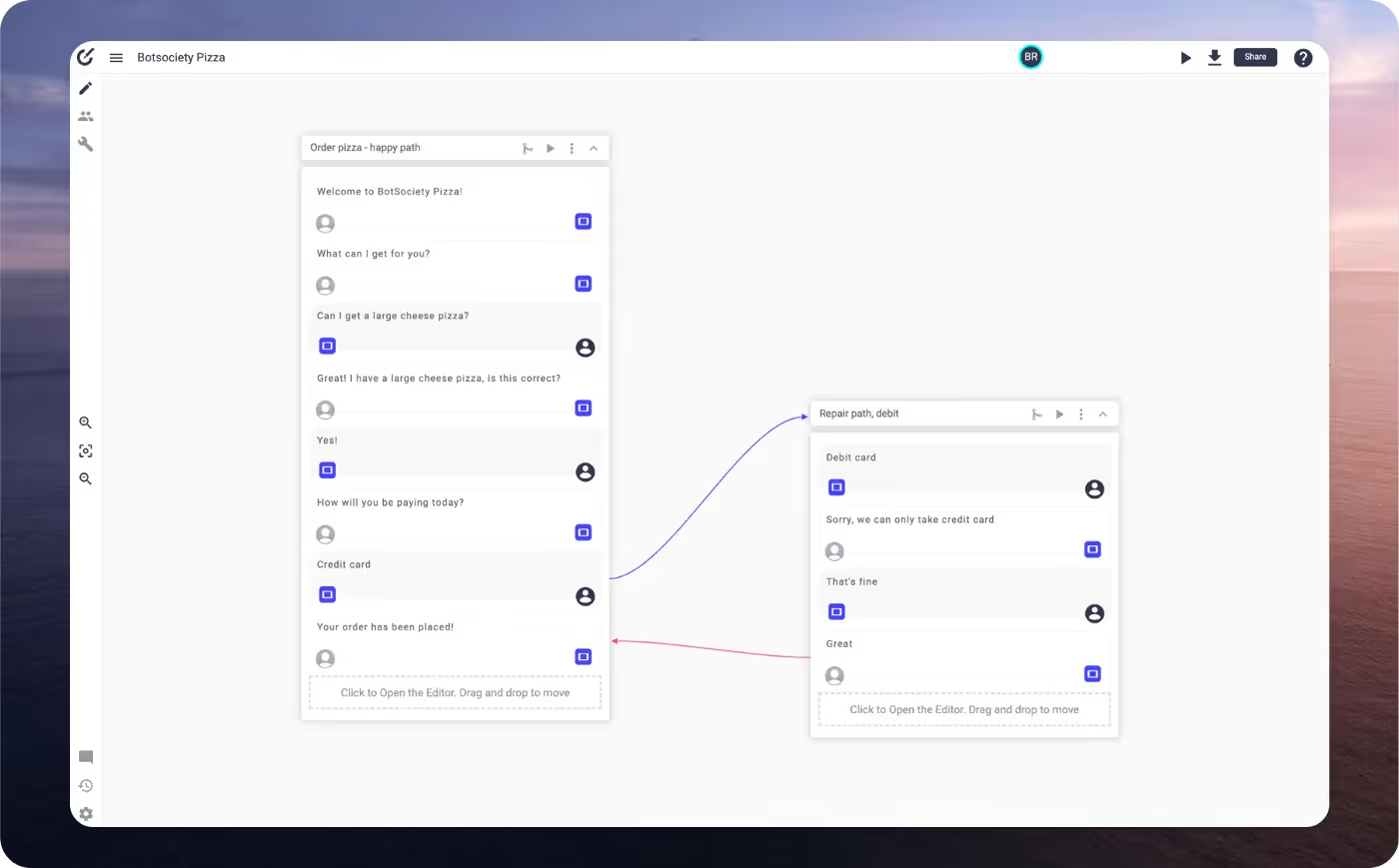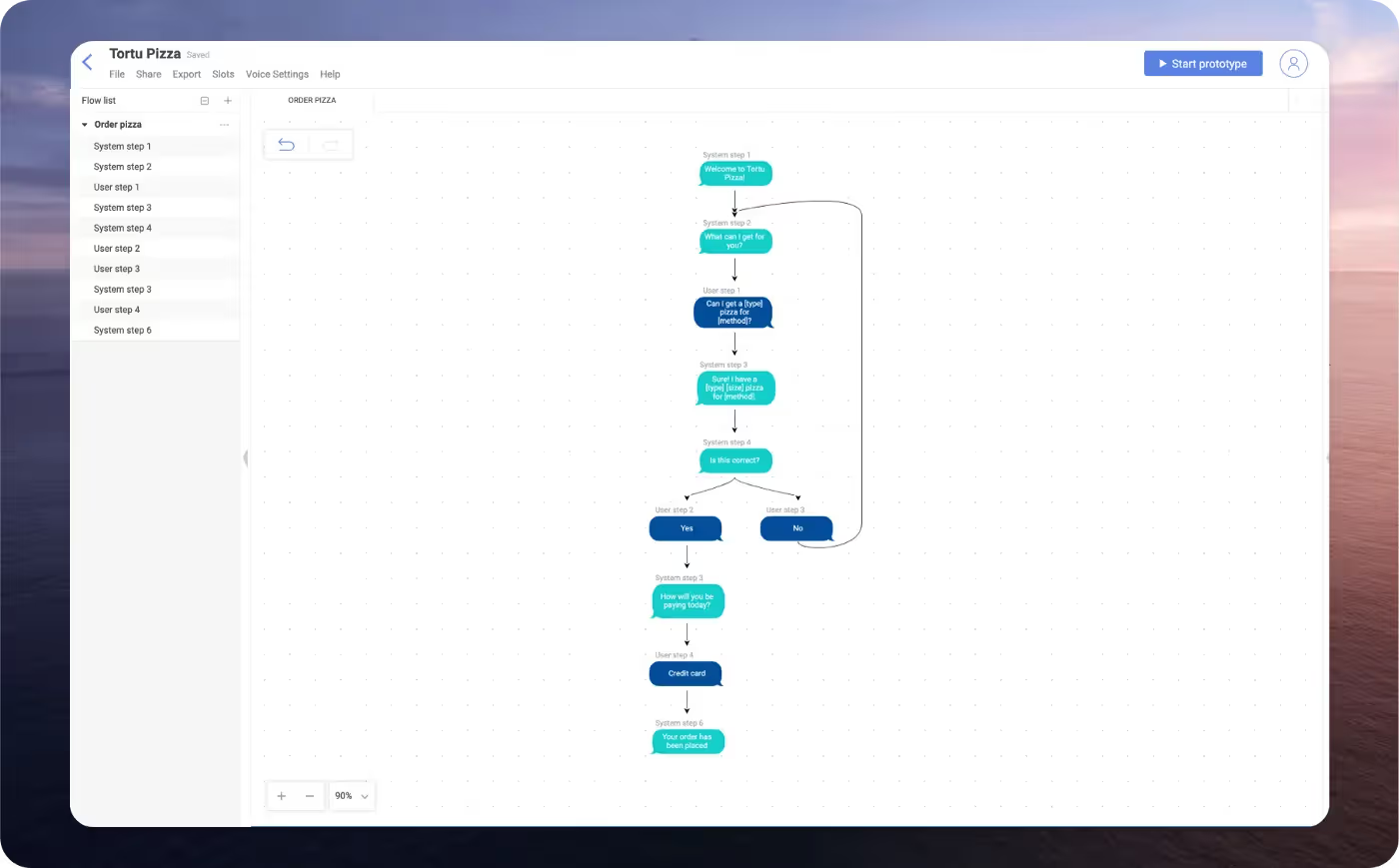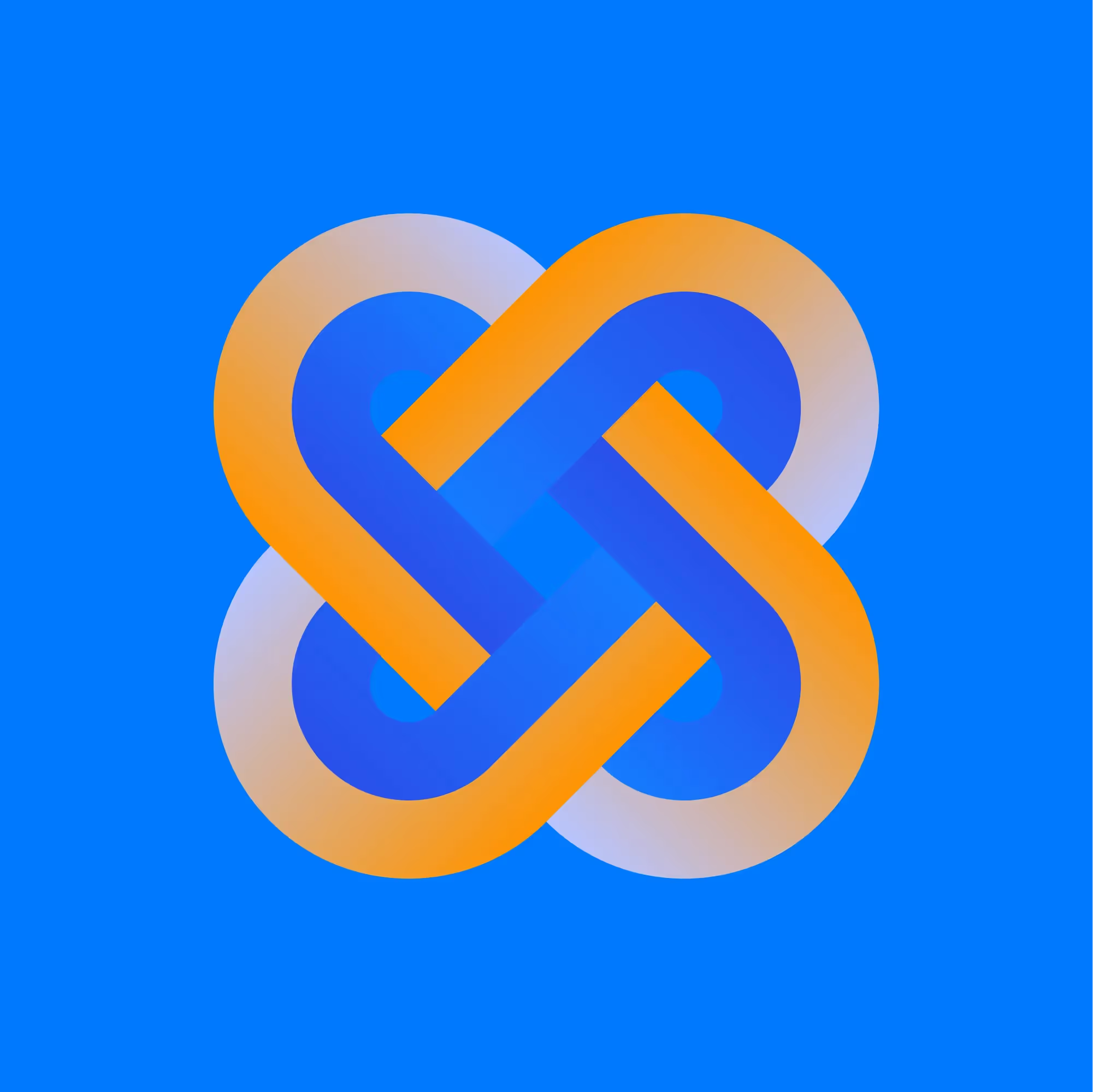What I look for in a conversation design tool
When evaluating conversation design tools, I examine five key areas:
- Ease of use
- Collaboration
- Integrations / exports
- Design fidelity
- Prototyping
By nature, product design is always faced with a series of trade-offs; there is no one perfect tool for every designer or team. In this article, I broke down the pros/cons of each design tool based on the categories above.
This list was assembled in January of 2021, and so if you've stumbled upon this blog since then, it's important to remember that products change rapidly over time. I recommend trying all of these tools to get a feel for the one that best suits your use case.
There was one category I purposely left out: the "feel"of the tool. That will ultimately be up to you and your comfort level working inside each.
Ease of use

Voiceflow
Pros: Voiceflow features a drag-and-drop infinite canvas design that makes it an easy tool to pick up for beginners.
Cons: Voiceflow’s advanced design features such as context layering, reusable components, and non-linear intent design create a steeper learning curve for some designers.

Botsociety
Pros: BotSociety leverages a script based design format. The script design format makes it easy to transition from sample dialogs to design.
Cons: BotSociety’s script-design format can be limiting when designing multi-turn conversations that branch outside the happy path, or contain complex repair paths.

Fabble
Pros: Fabble leverages a simple canvas point-and-click system for design that helps you get up and running with ease. Fabble also has a really nice layout similar to professional design tools, including a tab system for designing multiple flows.
Cons: The UI/UX of the canvas - particularly the creation of lines and the use of multiple slots within an utterance can become a little difficult as your project expands.

Adobe XD
Pros: Adobe XD has a high-fidelity visual design canvas that also features a desktop app for creative professionals.
Cons: Adobe XD is a visual design tool first, so designing conversations without visuals is not easy nor expected (see above).
Collaboration
Voiceflow
Pros: Voiceflow supports leading design tool collaboration features including real-time collaboration, commenting, shared workspaces, and user permissions.
Cons: Many of Voiceflow’s collaboration features require a paid plan. Voiceflow’s versioning system is snapshot-based.
Botsociety
Pros: Botsociety supports real-time collaboration, commenting, shared workspaces, and versioning.
Cons: Botsociety lacks workspace level user permissions, but otherwise has a great collaboration suite.
Fabble
Pros: Fabble supports some basic versioning, but is otherwise lacking in collaboration. They are now focusing on teams and should add further support soon.
Cons: Fabble is focused on the individual designer experience and does not support many collaborative features yet.
Adobe XD
Pros: Adobe XD supports real-time collaboration, commenting, great versioning, and workspaces.
Cons: Adobe XD is desktop-only.
Design fidelity
Voiceflow
Pros: Voiceflow has the highest design fidelity of the four tools, allowing for advanced context modelling, escalating re-prompts, dialog management, the usage of conditional logic, live data, and intents/slots.
Cons: Voiceflow’s high design fidelity can lead to a steeper learning curve than the other tools. To complement prototype parity, Voiceflow prototypes operate within the confines of whatever channel the designer chooses (i.e. Alexa, Google, In-Car etc.).
BotSociety
Pros: Botsociety supports branching and error paths as well as a great SSML editor for response fidelity. Botsociety also has nice visual in device frames for prototyping multi-modal experiences.
Cons: Botsociety isn’t able to model context or handle intents/slots, and so the fidelity of the design will be limited to a “happy-path plus” design. This won’t be a limitation for many designers early in the workflow but this may pose a problem during user testing and dev-handoff.
Fabble
Pros: Fabble allows for the creation of multiple flows, which enforces best practices of breaking your design into various segments. Fabble also allows for branching and some intent/slot definition.
Cons: Fabble will be great for early designs but suffers from a “fidelity ceiling” later in the design process as Cx Designers approach unguided user testing.
Adobe XD
Pros: Adobe XD does a great job with multi-modal design as you can create the visuals directly within XD.
Cons: Adobe XD lacks any conversation design capabilities outside voice command-driven design for visual displays.
Integrations / exports
Voiceflow
Pros: Voiceflow allows for deep developer integrations and code export options. Voiceflow is the only tool that can perform runtime code exports and production hosting.
Cons: While Voiceflow’s SDK allows for integration with any assistant platform, it only supports native integrations with Amazon Alexa and Google Assistant.
Botsociety
Pros: Botsociety has a few unique features, including the ability to record a video of your test and export - useful for user testing and explaining designs. They also support the standard JSON, PDF/PNG exports along with exporting to Dialogflow for prototyping.
Cons: Botsociety doesn’t allow for self-service integrations at the NLP/NLU level or code-level exports. Botsociety’s Dialogflow integration requires some manual reworking within the design to turn it into a working prototype.
Fabble
Pros: Fabble does the best job of the four tools providing the basic export options including response export, JSON, PDF/PNG, and a project export.
Cons: Fabble’s export options are surface-level, and don’t allow for custom integrations or runtime support. This means prototyping is done within Fabble’s tool, and the work cannot be exported elsewhere without manual data transformation.
Adobe XD
Cons: Adobe XD lacks integrations or developer exports.
Prototyping
Voiceflow
Pros: Voiceflow has strong prototyping functionality thanks to its high design fidelity, allowing for unguided user testing. Voiceflow also supports both in-browser and on-device testing for Alexa and Google Assistant.
Cons: Voiceflow’s chat prototypes do not currently support features like carousels and embeds that are common in chat platforms like Messenger.
Botsociety
Pros: Botsociety’s prototyping allows for rapid iteration on most major platforms as well as prototype sharing via link. Botsociety is also working on auto-testing (excited to see how this turns out).
Cons: Botsociety doesn’t support rapid on-device testing. Tests aren’t high fidelity as they’re predominately happy path-based.
Fabble
Pros: Fabble allows for text, chip, and voice prototyping as well as manual test controls for Wizard of Oz testing. Fabble also supports sharing tests via URL.
Cons: Fabble’s designs aren’t high-fidelity, meaning tests cannot be unguided unless they are restricted to chips. Fabble doesn’t allow for testing on-device.
Adobe XD
Pros: Adobe XD supports on-device prototyping for Alexa through their Adobe XD Alexa Skill. Adobe XD also supports mobile, web, and custom visual format prototypes which is a big plus.
Cons: Adobe XD’s prototypes are command-driven and lack conversational fidelity outside of the ability to change screens.
Wrapping up
I hope this gives you a better understanding of the conversation design tool landscape. There won't be a tool for everyone and every use case, but understanding each tool's abilities and restrictions will help you nail down the right tool for you and the task at hand.
What I look for in a conversation design tool
When evaluating conversation design tools, I examine five key areas:
- Ease of use
- Collaboration
- Integrations / exports
- Design fidelity
- Prototyping
By nature, product design is always faced with a series of trade-offs; there is no one perfect tool for every designer or team. In this article, I broke down the pros/cons of each design tool based on the categories above.
This list was assembled in January of 2021, and so if you've stumbled upon this blog since then, it's important to remember that products change rapidly over time. I recommend trying all of these tools to get a feel for the one that best suits your use case.
There was one category I purposely left out: the "feel"of the tool. That will ultimately be up to you and your comfort level working inside each.
Ease of use

Voiceflow
Pros: Voiceflow features a drag-and-drop infinite canvas design that makes it an easy tool to pick up for beginners.
Cons: Voiceflow’s advanced design features such as context layering, reusable components, and non-linear intent design create a steeper learning curve for some designers.

Botsociety
Pros: BotSociety leverages a script based design format. The script design format makes it easy to transition from sample dialogs to design.
Cons: BotSociety’s script-design format can be limiting when designing multi-turn conversations that branch outside the happy path, or contain complex repair paths.

Fabble
Pros: Fabble leverages a simple canvas point-and-click system for design that helps you get up and running with ease. Fabble also has a really nice layout similar to professional design tools, including a tab system for designing multiple flows.
Cons: The UI/UX of the canvas - particularly the creation of lines and the use of multiple slots within an utterance can become a little difficult as your project expands.

Adobe XD
Pros: Adobe XD has a high-fidelity visual design canvas that also features a desktop app for creative professionals.
Cons: Adobe XD is a visual design tool first, so designing conversations without visuals is not easy nor expected (see above).
Collaboration
Voiceflow
Pros: Voiceflow supports leading design tool collaboration features including real-time collaboration, commenting, shared workspaces, and user permissions.
Cons: Many of Voiceflow’s collaboration features require a paid plan. Voiceflow’s versioning system is snapshot-based.
Botsociety
Pros: Botsociety supports real-time collaboration, commenting, shared workspaces, and versioning.
Cons: Botsociety lacks workspace level user permissions, but otherwise has a great collaboration suite.
Fabble
Pros: Fabble supports some basic versioning, but is otherwise lacking in collaboration. They are now focusing on teams and should add further support soon.
Cons: Fabble is focused on the individual designer experience and does not support many collaborative features yet.
Adobe XD
Pros: Adobe XD supports real-time collaboration, commenting, great versioning, and workspaces.
Cons: Adobe XD is desktop-only.
Design fidelity
Voiceflow
Pros: Voiceflow has the highest design fidelity of the four tools, allowing for advanced context modelling, escalating re-prompts, dialog management, the usage of conditional logic, live data, and intents/slots.
Cons: Voiceflow’s high design fidelity can lead to a steeper learning curve than the other tools. To complement prototype parity, Voiceflow prototypes operate within the confines of whatever channel the designer chooses (i.e. Alexa, Google, In-Car etc.).
BotSociety
Pros: Botsociety supports branching and error paths as well as a great SSML editor for response fidelity. Botsociety also has nice visual in device frames for prototyping multi-modal experiences.
Cons: Botsociety isn’t able to model context or handle intents/slots, and so the fidelity of the design will be limited to a “happy-path plus” design. This won’t be a limitation for many designers early in the workflow but this may pose a problem during user testing and dev-handoff.
Fabble
Pros: Fabble allows for the creation of multiple flows, which enforces best practices of breaking your design into various segments. Fabble also allows for branching and some intent/slot definition.
Cons: Fabble will be great for early designs but suffers from a “fidelity ceiling” later in the design process as Cx Designers approach unguided user testing.
Adobe XD
Pros: Adobe XD does a great job with multi-modal design as you can create the visuals directly within XD.
Cons: Adobe XD lacks any conversation design capabilities outside voice command-driven design for visual displays.
Integrations / exports
Voiceflow
Pros: Voiceflow allows for deep developer integrations and code export options. Voiceflow is the only tool that can perform runtime code exports and production hosting.
Cons: While Voiceflow’s SDK allows for integration with any assistant platform, it only supports native integrations with Amazon Alexa and Google Assistant.
Botsociety
Pros: Botsociety has a few unique features, including the ability to record a video of your test and export - useful for user testing and explaining designs. They also support the standard JSON, PDF/PNG exports along with exporting to Dialogflow for prototyping.
Cons: Botsociety doesn’t allow for self-service integrations at the NLP/NLU level or code-level exports. Botsociety’s Dialogflow integration requires some manual reworking within the design to turn it into a working prototype.
Fabble
Pros: Fabble does the best job of the four tools providing the basic export options including response export, JSON, PDF/PNG, and a project export.
Cons: Fabble’s export options are surface-level, and don’t allow for custom integrations or runtime support. This means prototyping is done within Fabble’s tool, and the work cannot be exported elsewhere without manual data transformation.
Adobe XD
Cons: Adobe XD lacks integrations or developer exports.
Prototyping
Voiceflow
Pros: Voiceflow has strong prototyping functionality thanks to its high design fidelity, allowing for unguided user testing. Voiceflow also supports both in-browser and on-device testing for Alexa and Google Assistant.
Cons: Voiceflow’s chat prototypes do not currently support features like carousels and embeds that are common in chat platforms like Messenger.
Botsociety
Pros: Botsociety’s prototyping allows for rapid iteration on most major platforms as well as prototype sharing via link. Botsociety is also working on auto-testing (excited to see how this turns out).
Cons: Botsociety doesn’t support rapid on-device testing. Tests aren’t high fidelity as they’re predominately happy path-based.
Fabble
Pros: Fabble allows for text, chip, and voice prototyping as well as manual test controls for Wizard of Oz testing. Fabble also supports sharing tests via URL.
Cons: Fabble’s designs aren’t high-fidelity, meaning tests cannot be unguided unless they are restricted to chips. Fabble doesn’t allow for testing on-device.
Adobe XD
Pros: Adobe XD supports on-device prototyping for Alexa through their Adobe XD Alexa Skill. Adobe XD also supports mobile, web, and custom visual format prototypes which is a big plus.
Cons: Adobe XD’s prototypes are command-driven and lack conversational fidelity outside of the ability to change screens.
Wrapping up
I hope this gives you a better understanding of the conversation design tool landscape. There won't be a tool for everyone and every use case, but understanding each tool's abilities and restrictions will help you nail down the right tool for you and the task at hand.






.svg)